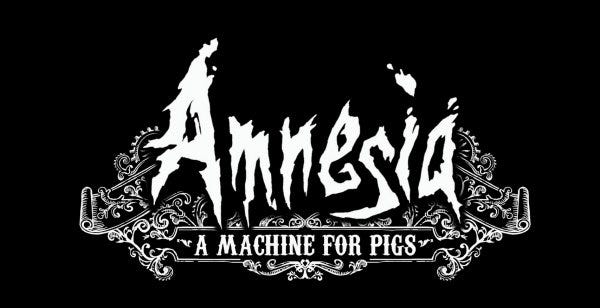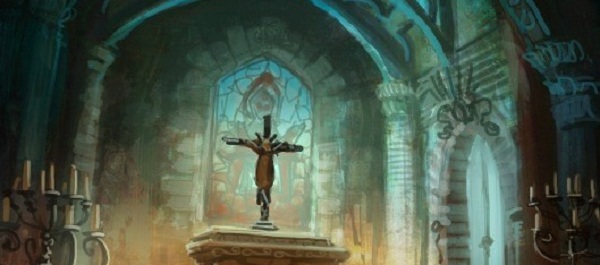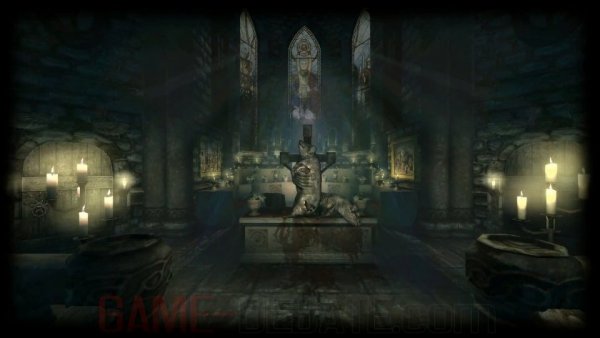Fin De Siècle: Amnesia - A Machine For Pigs
Swine and Dine
I’ve spent most of the week thinking about Amnesia: A Machine For Pigs. I finished the story at the weekend and spent the last five minutes of the game with a huge grin plastered across my face. Not the reaction that a horror game might hope to elicit but thechineseroom’s cleverly concealed secret, hidden behind the dark curtain of that title, is that in some ways they haven’t really constructed a horror game at all. Thankfully, they’ve made something far more interesting instead.
It’s very difficult to talk about what A Machine For Pigs actually is, rather than all the trappings that come from the Amnesia bit of the title, without detracting from its power. If you haven’t finished the game yet, probably best not to read too much of my witterings, but there will be another warning before we pass the point of no return.
Let's talk about what the game is then. It’s the story of a Machine, of course, an enormous contraption, all gears and steam, and as we expected, the Machine slaughters pigs and other assorted swine.
As if the title wasn’t suggestive enough, the trailer makes explicit what everyone had surely guessed. The Machine for Pigs was never going to be a trotter-friendly touchscreen tablet but it was also unlikely that hogs would be the only grist to the slaughter-mill. The final line of the trailer conjures cannibalism, mechanised mass murder and the vanishing/victimisation of an underclass.
“That all rather depends, Professor, on what one considers to be a pig.”
But, then, maybe it’s not the dispossessed and the forgotten that are to be fed to the machine. Perhaps it’s the upper class that will fill the role of swine? Selecting a specific target for vitriol at the anxious end of the nineteenth century in London isn’t simple. While Britain was recoiling in just about every manner that the word suggests – like a fist, a punchdrunk pugilist, a snake – social structures were undergoing recalibration as the dispersal of information, ease of travel and rise of the machines carried both threat and promise.
AMFP revels in those anxieties and the writing is as interested in the period and the place as it is in sending shivers up the spine. There are precious few chases or games of hide and seek, and I finished the entire game without dying. In fact, I don’t even know if it’s possible to die. Several times, I was wounded and cowered in the dark, bleeding, but there are no health bars or sanity meters – even the lantern is eternally charged. Dropping the inventory system and mechanics of its predecessors, AMFP does not allow confrontations and death to detract from its narrative.
During the opening couple of hours, when the total deviation from Amnesia’s template is less obvious, I missed the mechanical parts of the game. There’s precious little to do and, as Jim noted, the phantom children who act as motivation and bait are unconvincing – we’ve seen them too often before and they seem like a borrowing from a lesser place. Being charitable, I reckon that might be the point – they are a horror trope that has survived from 1899 to the present, a reminder that very little changes in a game that is, at its foundation, about the fear of change. That’s a stretch though. They’re probably just slightly naff ghost kids, although they do have a significant role to play as the story develops.
There are bumps in the night and blood stains on the floor, but it’s the details of the world that disturb rather than the broad strokes and the loud noises. The cages on the beds and the elaborate locks on the doors. These do more than limit the player’s freedom. Everything exists for a reason and, yes, the world has less points of interaction than Dark Descent’s and objects can’t all be thrown about the place, but there’s a great deal more to see.
The Dark Descent certainly fits the form of what I’d consider a pure scare ‘em up and it’s an excellent example of that form, content for its plot to lumber in the shadows for most of its length, while it concentrates on saying ‘BOO’. It does so convincingly, until, like an overworked CGI monster, the narrative finally emerges, and drains the tension and fear with a cosmic guff of hot air. The recently released Outlast is of the same ilk, although it leans heavily on its impressive technology to keep things interesting, a trick that wasn’t enough to keep me invested during the short running time. I can only run away from grunting maniacs so many times, through corridors lined with intestines and severed heads, before I become desensitised to their plight and my own.
A Machine For Pigs is different. It deserves mention in the same breath as Silent Hill 2, the great example of character-based interactive psychological horror.
The excellent and too-much ignored Shattered Memories aside, Konami’s series hasn’t come close to the heights of its second entry, nor have the sequels even aimed for that peak. Nothing really has. Whether it was heading for the same ground or not, A Machine For Pigs finds itself in Silent Hill’s neighbourhood. The themes that it eventually settles on are psychosocial rather than psychosexual - although there are plenty of parted haunches and a great confusion of fluids – but both games find their strength in the use of various forms of the horrific and the weird to reflect something recognisably disturbing.
And now, if you haven’t played, stop. Or continue a word at a time. I’m not going to reveal that the Machine is actually a spaceship or that the pigs are actually puppies – it’s not that sort of a story. I am going to unpick aspects of the narrative though, in a way that will reduce the enjoyment of experiencing them without prior warning or analysis.
Here we go then. Monsters are metaphors. The best monsters, anyway. The ones that get under our skin, between the membranes of our minds and into our memories. Bloodsuckers, flesheaters and parasites are formed from our urges, fears and desires, while phantoms and banshees tap into folk histories, and personal tragedies and regrets. AMFP takes the fin de siècle angst of a society and crams them into the overcrowded mind of a single man, the game’s proto-antagonist, an explorer/father/industrialist/butcher who has become lost between the tick and the tock of time’s passing.
His adventures to the ruins of other civilizations pre-empt the destruction of all that is civilized in his own world, but as he plays the archaeologist he is also stamping in the footsteps of the conquistadors. Restoration and recovery are inextricably linked with destruction. He returns with conquest on his mind but he is not intent on terrorising, instead he brands himself, in part, a philanthropist. His aim is to feed, to nurture and to father, and those instincts mingle with his fears to become part of a deeper paternalism, running through the veins of Empire. The milk of human kindness, polluted by the needs of industry, commerce and war, eventually runs red.
Just as Mandus is many things, so is his Machine. It is, at times, his dead wife, an anatomical and erotic structure that is also a prison, like Iain Banks’ Bridge. At other times it belongs on a factory line, or in an abattoir, producing and processing, but its true purpose is elusive, even as its innards are revealed. The descent to the heart of the device comprises the bulk of the game and the writing deserves a great deal of credit for its ability to maintain a sense of mystery throughout.
From an obvious starting point, the journey inward takes unexpected turns, although 'turns' may be the wrong term. There are no twists, as such, but rather the sense of a storyteller warming to a theme, elaborating and weaving new threads, or an orchestra adding new sections to its symphony as the music swells and changes. And that’s why I had a big grin on my face when the game ended. The finale is a performance and the rest is prologue. In the final moments, the game bellows, unashamedly pleased with the place it has found and the pitch of its delivery. It more than earns that right.
With AMFP and Outlast released so close together, I found it hard not to see the former as a riposte. That’s not the case, of course, but even with the caveat of Evil Corporate Experimentation, Outlast asks us to fear the madness of others. A Machine For Pigs is about fear of the self, whether it be the actions taken or the inability to act, and it ends with an agonised vision of the atrocities of the 20th century, the one that begins as the game ends and the one that our world survived, although not unscathed.
Mandus doesn’t believe that anything will survive and, as he clutches the ruins of his family and his own life, the many metaphors of the Machine come together. It is progress, it is mechanisation and it is the future. At one point, as the player emerges from the belly of the beast, explosions wrack London. It’s the sound of war, apocalyptic and urgent, and it seemed entirely natural at that point. The world hadn't changed - the violence was always waiting in the wings or cringing behind a veil. Those sounds are Matthew Arnold’s “confused alarms of struggle and flight / Where ignorant armies clash by night” and, in its own strange way, A Machine For Pigs works as a splendid cover version of Dover Beach.
Unlike the poem, this story ends with hope. Not for Mandus but for the rest of us. The thing that he fears so much has come to be and, terrible as it was, we're still here. That’s a good thing, isn’t it? Even if we are building more machines by the minute.





